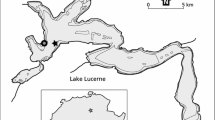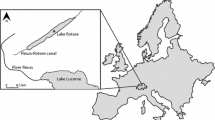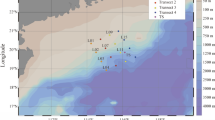Abstract
Seasonal cycles of concentrations and microbial uptake of dissolved free amino acids and the polyamine, putrescine, were followed during summer stratification of a coastal salt pond. Stratification began in May and was clearly seen in profiles of temperature, salinity, pH and alkalinity. Primary production exhibited a mid-August maximum and the O2-H2S interface shoaled at that time. POC and phytopigments roughly followed the pattern of primary production. Cycling of putresince, like the amino acids, was strongly influenced by primary production and microbial decomposition. Putrescine concentration profiles appeared to follow the pattern of primary production more closely, while amino acids appeared to follow the pattern of microbial production. The absence of production of putrescine during the decomposition of dissolved ornithine and the correlation of putrescine concentration with primary production suggest a direct source from algae in the water column.
Microbial uptake of amino acids and putrescine together accounted for 60–90% of the bacterial C production measured in oxic waters and almost 300% of that measured in the anoxic bottom layer. Since other organic carbon and nitrogen compounds are also being taken up, these data suggest that tracer uptake methods as we used them may overestimate the true microbial uptake rates, or release of other organic compounds by microbes occurs at the same time. Further work on carbon and nitrogen budgets is needed to resolve the apparent imbalance between organic C and N incorporation and bacterial production.
Similar content being viewed by others
References
Young HE, Ribe JH & Wainwright K (1980) Weight Tables for Tree and Shrub Species in Maine. Miscellaneous Report 230, Life Sciences and Agriculture Experiment Station, University of Maine, Orono, Maine Andersson A, Lee C, Azam F & Hagström (1985) Release of amino acids and inorganic nutrients by heterotrophic marine microflagellates. Mar. Ecol. Prog. Ser. 23: 99–106
Azam F & Hodson RE (1977) Size distribution and activity of marine microheterotrophs. Limnol. Oceanogr. 22: 492–501
V Bachrach (1973) Function of Naturally Occurring Polyamines Academic Press New York
Bachrach V (1973) Function of Naturally Occurring Polyamines. Academic Press, New York, 211 pp Billen G, Joiris C, Wijnant J & Gillain G (1980) Concentration and microbiological utilization of small organic molecules in the Scheldt Estuary, the Belgian coastal zone of the North Sea and the English Channel. Est. Coastal Mar. Sci. 11: 279–294
Bjørnsen PK (1986) Automatic determinations of bacterioplankton biomass by means of image analysis. Appl. Envir. Microbiol. 51: 1199–1204
SS Cohen (1971) Introduction to the Polyamines Prentice-Hall Englewood Cliffs, NJ
Cohen SS (1971) Introduction to the Polyamines. Prentice-Hall, Englewood Cliffs, NJ, 179 pp Fuhrman J (1987) Close coupling between release and uptake of dissolved free amino acids in seawater studied by an isotope dilution approach. Mar. Ecol. Progr. Ser. 37: 45–52
Fuhrman J & Azam F (1980) Bacterioplankton secondary production estimates for coastal waters of British Columbia, Antarctica and California. Appl. Environ. Microbiol. 39: 1085–1095
Galston AW (1983) Polyamines as modulators of plant development. Bioscience 33: 382–388
Hobbie JE & Crawford CC (1969) Respiration corrections for bacterial uptake of dissolved organic compounds in natural waters. Limnol. Oceanogr. 14: 528–532
Höfle MG (1984) Degradation of putrescine and cadaverine in seawater cultures by marine bacteria. Appl. Envir. Microbiol. 47: 843–849
Jones BM, Pääbo S & Stein S (1981) Amino acid analysis and enzymatic sequence determination of peptides by an improved o-phthaldialdehyde precolumn labeling procedure. J. Liq. Chromatogr. 4: 565–586
Jørgensen NOG, Kroer N, Coffin RB, Yang X-H & Lee C (1993) Dissolved free amino acids, combined amino acids, and DNA as sources of carbon and nitrogen to marine bacteria. Mar. Ecol. Progr. Ser. 98: 135–148
Keil RG & Kirchman DL (1991) Contribution of dissolved free amino acids and ammonium to the nitrogen requirements of heterotrophic bacterioplankton. Mar. Ecol. Progr. Ser. 73: 1–10
Kim CM & Emery KO (1971) Salt Pond: topography, sediments, and water. Salt Pond Areas Bird Sanctuaries, Inc., Annual Report, Falmouth, MA
Larsson U & Hagström (1982) Fractionated phytoplankton primary production, exudate release and bacterial production in a Baltic eutrophication gradient. Mar. Biol. 67: 57–70
Lee C (1992) Controls on organic carbon preservation: the use of stratified water bodies to compare intrinsic rates of decomposition in oxic and anoxic systems. Geochim. Cosmochim. Acta 56: 3323–3335
Lee C & Cronin C (1982) The vertical flux of particulate organic nitrogen in the sea: decomposition of amino acids in the Peru upwelling area and the Equatorial Atlantic. J. Mar. Res. 40: 227–251
AL Lehninger (1970) Biochemistry Worth Publishers New York
Lehninger AL (1970) Biochemistry. Worth Publishers, New York Lindroth P & Mopper K (1979) High performance liquid chromatographic determinations of subpicomole amounts of amino acids by precolumn fluorescence derivatization with o-phthaldialdehyde. Anal. Chem. 51: 1667–1674
Lohrenz SE, Taylor CD & Howes BL (1987) Primary production of protein: II. Algal protein metabolism and its relation to particulate organic matter composition in the surface mixed layer. Mar. Ecol. Progr. Ser. 40: 175–183
Martin-Jézéquel V, Sournia A & Birrien JL (1992) A daily study of the diatom spring bloom at Roscoff (France) in 1985. J. Plankton Res. 14: 409–421
DE Metzler (1977) Biochemistry Academic Press New York
FMM Morel (1983) Principles of Aquatic Chemistry Wiley & Sons New York
Metzler DE (1977) Biochemistry. Academic Press, New York Morel FMM (1983) Principles of Aquatic Chemistry. Wiley & Sons, New York Nagata T & Kirchman DL (1991) Release of dissolved free and combined amino acids by bactiverous marine flagellates. Limnol. Oceanogr. 36: 433–443
Palenik BP & Morel FMM (1990) Amino acid utilization by marine phytoplankton: a novel mechanism. Limnol. Oceanogr. 35: 260–269
Pantoja S & Lee C (1994) Cell-surface oxidation of amino acids in seawater. Limnol. Oceanogr. 39: 1718–1726
TR Parsons Y Maita CM Lalli (1984) A Manual of Chemical and Biochemical Methods for Seawater Analysis Pergamon Press New York
Parsons TR, Maita Y & Lalli CM (1984) A Manual of Chemical and Biochemical Methods for Seawater Analysis. Pergamon Press, New York Riemann B, Jørgensen NOG, Lampert W & Fuhrman JA (1986) Zooplankton induced changes in dissolved amino acids and in production rates of freshwater bacteria. Microb. Ecol. 12: 247–258
Simon M & Azam F (1989) Protein content and protein synthesis rates of planktonic marine bacteria. Mar. Ecol. Progr. Ser. 51: 201–213
Smits J & Riemann B (1988) Cell production derived from3H-thymidine incorporation using freshwater bacteria. Appl. Envir. Microbial. 54: 2213–2219
Strickland JDH & Parsons TR (1972) A Practical Handbook of Seawater Analysis. Bull. 167, Fish. Res. Bd. Canada
Stumm W & Morgan JJ (1981) Aquatic Chemistry. Wiley & Sons New York
Wakeham SG, Howes BL & Dacey JWH (1984) Dimethylsulphide in a stratified coastal salt pond. Nature 310: 770–772
Wakeham SG, Howes BL, Dacey JWH, Schwarzenbach RP & Zeyer J (1987) Biogeochemistry of dimethylsulfide in a seasonally stratified coastal salt pond. Geochim. Cosmochim. Acta 51: 1675–1684
Wellsbury P, Herbert RA & Parkes RJ (1993) Incorporation of [methyl-3H]-thymidine by obligate and facultative anaerobic bacteria when grown under defined culture conditions. FEMS Microbiol. Ecol. 12: 87–95
Welschmeyer NA & Lorenzen CJ (1985) Chlorophyll budgets: zooplankton grazing and phytoplankton growth in a temperate fjord and the Central Pacific Gyres. Limnol. Oceanogr. 30: 1–21
Williams PJLeB, Berman T & Holm-Hansen O (1976) Amino acid uptake and respiration by marine heterotrophs. Mar. Biol. 35: 41–47
Author information
Authors and Affiliations
Rights and permissions
About this article
Cite this article
Lee, C., Jørgensen, N.O.G. Seasonal cycling of putrescine and amino acids in relation to biological production in a stratified coastal salt pond. Biogeochemistry 29, 131–157 (1995). https://doi.org/10.1007/BF00000229
Received:
Accepted:
Issue Date:
DOI: https://doi.org/10.1007/BF00000229




